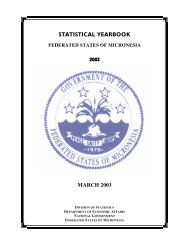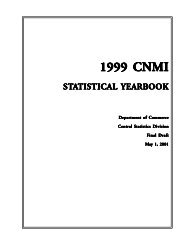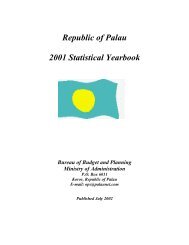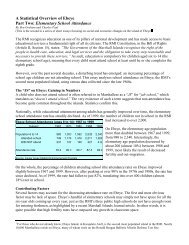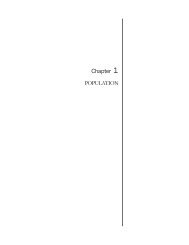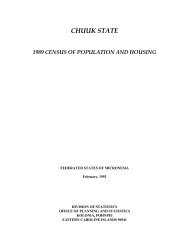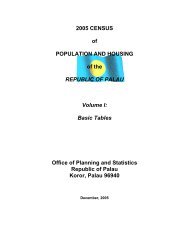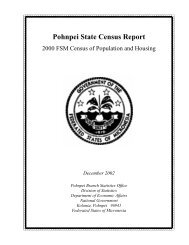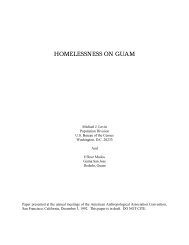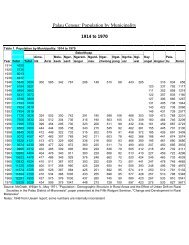Chuuk State Census Report - pacificweb.org
Chuuk State Census Report - pacificweb.org
Chuuk State Census Report - pacificweb.org
You also want an ePaper? Increase the reach of your titles
YUMPU automatically turns print PDFs into web optimized ePapers that Google loves.
2000 FSM <strong>Census</strong> of <strong>Chuuk</strong> <strong>State</strong>Chapter 8. EducationTable 8.4: Age-specific Enrollment Ratio by Age, <strong>Chuuk</strong> <strong>State</strong>: 1994 and 20001994 2000Lagoon Outer Islands Lagoon Outer IslandsAge <strong>Chuuk</strong> Total N.Nam. S.Nam. Faichuk Total Mortlocks Oksoritod Total N.Nam. S.Nam. Faichuk Total Mortlocks OksoritodTotal 56.3 57.6 59.9 59.8 52.6 51.3 62.0 38.2 56.4 55.3 57.1 55.3 53.4 66.3 62.6 57.13 4.3 4.2 6.7 2.9 2.6 4.7 2.4 8.3 8.3 8.1 9.0 6.5 8.7 7.8 6.7 11.04 21.5 21.8 27.0 23.3 14.7 20.1 19.9 20.3 27.5 26.1 29.5 18.8 28.8 29.0 33.7 29.45 57.3 58.3 60.4 59.6 55.1 53.7 69.2 34.8 60.9 58.0 59.3 56.8 57.8 59.1 73.8 65.96 75.0 78.1 75.9 80.0 78.7 63.4 80.2 45.1 80.5 79.0 70.6 84.8 82.0 82.4 91.3 78.87 80.7 83.2 84.6 85.2 79.6 72.0 91.5 47.1 86.7 86.2 80.8 88.3 89.7 88.0 96.8 78.88 83.1 87.2 86.4 89.5 86.0 69.1 85.6 48.1 88.0 88.2 84.6 90.4 89.4 94.6 91.1 83.09 86.1 90.0 89.9 93.2 86.7 73.6 92.4 49.1 87.0 86.5 84.1 87.2 87.9 89.9 97.4 78.910 85.2 88.0 86.7 90.4 87.2 75.3 94.4 49.0 88.9 88.7 85.1 90.6 90.3 78.3 93.8 84.711 84.9 89.6 90.6 90.1 87.7 69.9 89.8 47.1 87.0 86.4 84.8 85.2 88.8 84.5 95.1 82.012 83.8 86.1 86.4 87.7 84.4 75.9 92.5 53.7 84.6 83.6 81.9 85.1 83.8 79.2 92.6 80.813 81.1 83.2 85.9 85.3 77.6 73.8 91.1 51.8 84.0 81.8 85.3 79.5 80.5 85.5 93.2 86.414 76.7 78.7 83.6 79.2 71.6 68.8 85.1 46.6 76.3 75.2 81.4 71.3 71.5 93.8 86.7 72.415 70.5 73.4 79.3 70.4 65.9 59.5 74.8 40.8 71.4 69.5 77.4 66.7 63.7 91.7 75.4 80.116 59.0 61.2 71.6 60.7 45.7 50.0 60.4 38.5 60.3 58.2 68.5 50.3 51.1 97.6 67.5 68.217 47.5 47.4 55.3 48.3 34.3 48.2 51.7 44.4 44.4 44.2 56.3 39.2 32.5 97.1 40.9 48.518 36.1 35.4 43.4 29.8 28.8 39.1 41.9 35.7 34.1 34.1 46.1 30.5 20.5 70.6 25.4 41.419 28.3 27.8 35.8 26.9 16.5 30.3 20.7 38.8 24.3 24.3 33.3 20.1 16.1 49.4 16.8 31.820 20.2 19.9 25.6 19.5 12.4 21.5 16.4 28.2 16.4 16.3 22.7 15.0 9.9 33.2 11.0 22.821 18.2 18.7 21.3 19.4 14.3 16.5 17.4 15.2 12.7 11.4 16.0 12.2 5.6 20.2 11.3 21.122 15.4 15.8 16.4 20.1 11.1 13.9 11.1 16.7 9.7 9.6 16.9 6.5 3.9 21.5 3.5 18.223 13.4 12.5 13.9 15.7 7.9 16.9 12.0 22.5 8.2 6.6 9.8 4.9 4.3 11.9 9.9 16.224 11.1 10.7 14.5 9.8 6.3 12.7 10.5 15.4 7.6 6.5 10.3 5.5 3.0 12.6 8.5 14.4Source: 1994 & 2000 FSM <strong>Census</strong>, unpublished dataFigure 8.3 Age-Specific Enrollment Rates by Region, <strong>Chuuk</strong>: 2000Percent100806040North. NamoneasSouth. NamoneasFaichukMortlocksOksoritod2003 4 5 6 7 8 9 10 11 12 13 14 15 16 17 18 19 20 21 22 23 24AgeOne way to measure the progress achieved over the years in regard to the proportion of eligible population entering theschool system is to compare (or consider the rate of) enrollment in primary and high schools with the correspondingpotential primary and high school age population. The result is usually referred as "Gross Enrollment Ratio" (Shryock,et al., 1976). This approach could also be considered as an indirect method to assess the potential of presenteducational facilities in <strong>Chuuk</strong>.For <strong>Chuuk</strong> <strong>State</strong>, the age-level relationship was established as follows: for elementary level, enrollment in grades 1to 8 is expected for the population aged 6 to 13 years, and for high school, enrollment in grades 9 to 12 is expectedfor the population aged 14 to 17 years. In 2000, the gross enrollment ratio at elementary and secondary levels wasabout 93 percent and 78 percent, respectively (Table 8.5). According to this analysis, the coverage of the schoolsystem is better for elementary level education than for high school. It can also be seen from the table that while thecoverage of the eligible population at the elementary level of education was about the same for males and females,the coverage for high school level education was higher for females than males. This shows that females tended tostay in school longer to complete a high school level education compared to their male counterparts.<strong>Chuuk</strong> Branch Statistics Office, Division of Statistics, FSM Department of Economic Affairs 67



